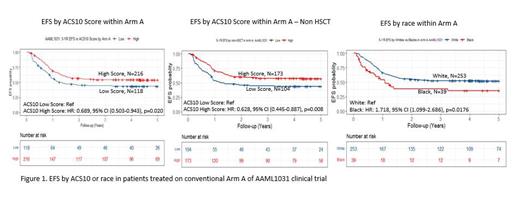Cytarabine (ara-C) has been used to treat acute myeloid leukemia (AML) for decades. While ara-C based regimens successfully induce remission in the majority of patients, significant number of patients experience relapse. Although advances in hematopoietic stem cell transplantation (HSCT) and supportive care regimens have improved over the years, it is imperative that personalized methods to optimize pharmacological intervention and improve outcomes are needed. To identify genetic predictors of ara-C response, we recently reported an ara-C pharmacogenomics score (ACS10) consisting of 10 SNPs in nine ara-C pathway genes (PMID: 34990262). In pediatric patients treated on AML02 and AAML0531 trials, low ACS10 score (<0) was associated with poor survival as compared to patients with high score (>0). Given these promising results, we sought to investigate the ACS10 score in a large cohort of children treated on Children's Oncology Group clinical trial AAML1031 (NCT01371981).
AAML1031 trial enrolled 1,097 newly diagnosed patients from 0 to 29.5 years of age that received either conventional AML treatment (ara-C, daunorubicin and etoposide (ADE): arm A) or conventional treatment with the addition of bortezomib (ADE+bortezomib: arm B). Overall, no benefit for adding bortezomib was observed (PMID: 32029509). The current study included 717 patients with both DNA specimens and clinical outcome data available. ACS10 SNPs were genotyped using Taqman assays and ACS10 score was calculated for each patient as per previous report (PMID: 34990262). Overall, for the 717 patients included in this study, 249 patients had low ACS10score (< 0) and 468 patients had a high ACS10 score (>0).
When combining patients treated on arm A and arm B, ACS10 score was not associated with overall survival (OS). However, patients with low ACS10 scores had poorer event-free survival (EFS) than those with high ACS10 scores, although this difference was not statistically significant (HR: 0.827, 95% CI (0.669-1.022), P=0.078). Patients with high ACS10 scores in arm A had improved EFS (HR: 0.689, 95% CI (0.50-0.94), P=0.023, Fig1), while OS did not show significant differences (P=0.378). Excluding the patients who received HSCT, showed increased EFS for patients with high ACS10 scores as compared to low ACS10 scores when treated with standard chemotherapy (HR: 0.628, 95% CI (0.445-0.887), P=0.008 Fig 1). In contrast, a significant difference was not observed within the standard ADE+bortezomib arm (arm B).
At the whole cohort level, black patients (N=84) had reduced OS (HR: 1.47, 95% CI (1.02-2.13), P=0.041) as compared to white patients, while there was no significant decrease in EFS (HR: 1.22, 95% CI (0.89-1.66), P=0.206) (N=522). Within arm A, black patients had significantly poorer outcome as compared to white patients (EFS, HR: 1.718, 95% CI (1.099-2.686), P=0.018 Fig1; OS HR: 1.80, 95% CI (1.05-3.10), P=0.032). Difference in outcome by race in arm B was not significant implying addition of bortezomib might have some benefit to black patients. Subsequent comparison by treatment arm showed a non-significant but better outcome in black patients when treated on arm B (Black patients: EFS, arm A vs. arm B: HR:0.66, 95% CI (0.37-1.17), P=0.154). Consistent with our previous investigation, low ACS10 score group was more abundant in black patients as compared to white patients (69% of black patients vs. 28% of white patients had low ACS10 score, P<0.001). These results are particularly salient given trends showing poor outcome in black as compared to white AML patients. Despite AAML1031 being one of the largest pediatric AML cohorts, the small number of black patients limited our ability to do further subset analyses by scores and arms (only 10 of 39 black patients treated on arm A had high ACS10 score).
In conclusion, we demonstrate the utility of the PGx-based ACS10 score in a large cohort of newly diagnosed pediatric AML patients when treated with standard ADE induction regimen. Consistent with previous observation, black patients with low ACS10 score had inferior outcome in standard arm, however such an association was not observed for the bortezomib arm. Higher abundance of the low ACS10 SNP scores in black patients warrants further in-depth evaluation. Our future and ongoing studies include compiling data from multiple clinical trials to increase the sample size as well as expanding investigations within Hispanic/Latino AML patients
Disclosures
No relevant conflicts of interest to declare.


This feature is available to Subscribers Only
Sign In or Create an Account Close Modal